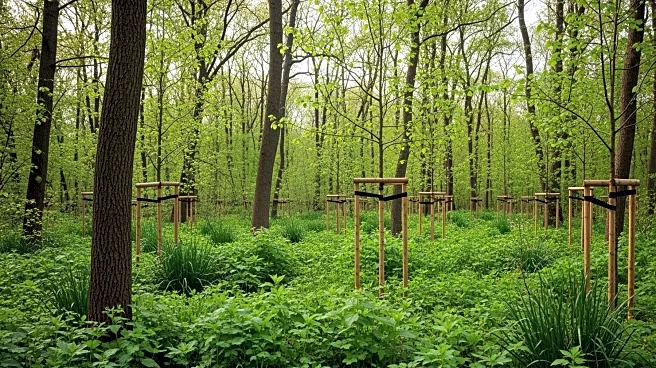What's Happening?
A study led by Dr. Elisa Fuentes-Montemayor from the University of Stirling has highlighted the benefits of hybrid approaches in woodland creation, combining natural colonisation with tree planting. The
research, conducted across 28 sites in England, found that hybrid methods result in woodlands with greater biodiversity and structural complexity compared to purely planted or naturally colonised areas. The study, which involved ecological surveys and interviews with over 500 land managers, is influencing national policy and funding schemes. The National Forest Company is developing new grants to support hybrid approaches, and Natural England has adapted its advice accordingly.
Why It's Important?
The findings of this study are significant for environmental policy and land management practices in the U.S. and beyond. Hybrid woodland creation methods offer a balanced approach that enhances biodiversity while allowing land managers to tailor outcomes to specific objectives. This approach could inform U.S. forestry practices, potentially leading to more sustainable and ecologically diverse forest landscapes. The study's influence on policy and funding schemes underscores the importance of integrating scientific research into practical applications, which could benefit conservation efforts and biodiversity in the U.S.
What's Next?
The study's results are expected to continue shaping woodland creation policies and practices. As the National Forest Company rolls out new grants, land managers will have more flexibility to implement hybrid approaches. This could lead to increased adoption of these methods, fostering more biodiverse and resilient forest ecosystems. Continued collaboration between researchers and practitioners will be crucial in refining these approaches and ensuring their effectiveness in different environmental contexts.
Beyond the Headlines
The study highlights the importance of interdisciplinary collaboration in environmental research. By combining ecological surveys with social science methods, the research provides a comprehensive understanding of land managers' perspectives and the practical implications of different woodland creation methods. This approach could serve as a model for future studies aiming to bridge the gap between scientific research and real-world application, promoting more effective and sustainable environmental practices.












